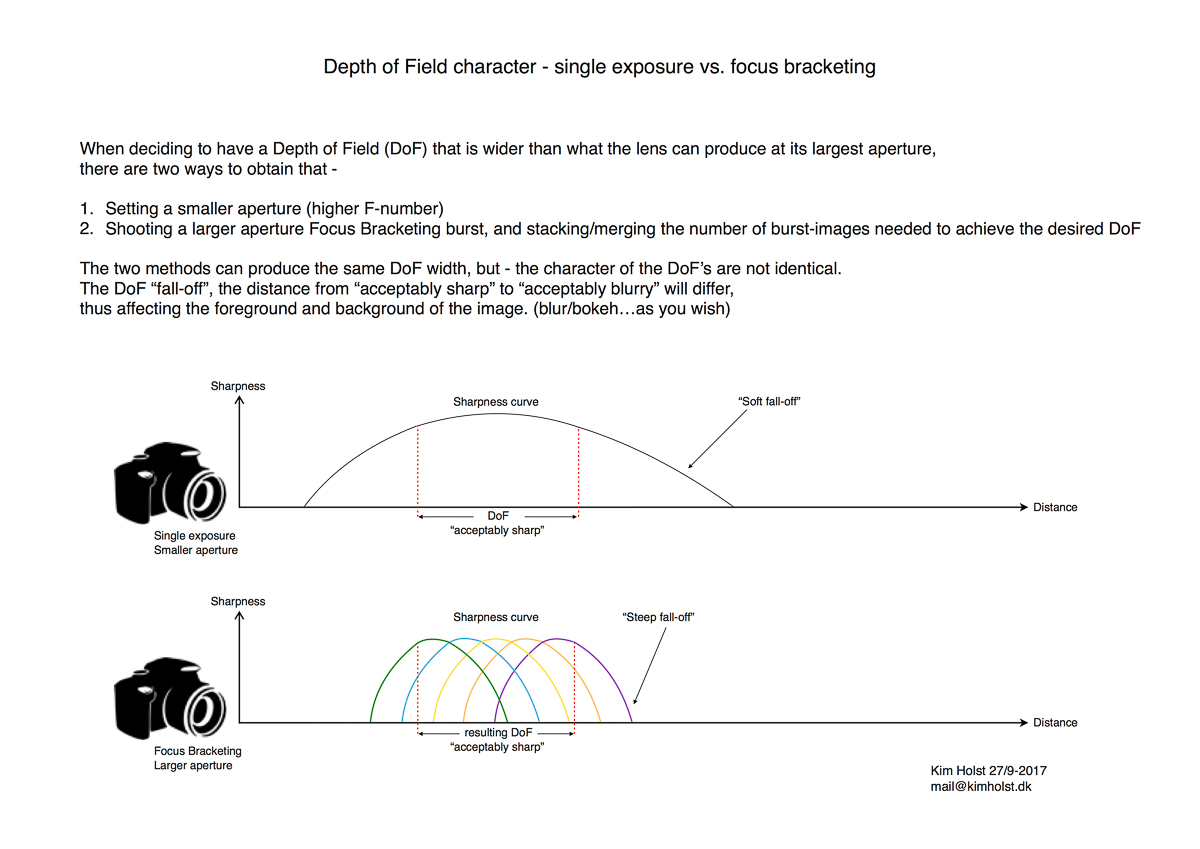omd:focus_stacking
Table of Contents
automatic in-camera focus stacking function for greater depth of field on Olympus cameras
see also:
introduction
- macrophotography of 3D subjects is problematic as the depth of field (DOF) is rarely deep enough to cover the whole subject, even when the aperture is stopped down to f/11-f/16
- capturing a subject 1cm in length from head to tail in perfect focus is a feat that all insect photographers wish to accomplish but when shooting at 1:1 macro, depth of field may only be 0.5mm
- stopping the aperture down too much looses image detail due to diffraction issues
- an option to address this issue is to take a series of photos with slightly different focus points then in post-processing with Photoshop or similar, combine these images and only display the in focus areas from each - this is called focus stacking
- now this is very tedious for most of use mere mortals so in 2015, Olympus kindly automated this procedure in-camera for their latest OM-D cameras as well as their Stylus TG-3 and TG-4 Tough cameras by including automatic focus bracketing and taking this a step further to automate the post-processing of these images in camera as “focus stacking” mode
- it can also be used in landscapes with very close foregrounds!
The above image was supplied to me for publishing here by Olympus photographer Kim Holst who created these nice explanatory diagrams
focus bracket mode method for static subjects
- from the menu, turn Bracketing on, select Focus Bracketing Mode, and set the number of shots and focus steps:
- focus steps are available from 1 to 10
- focus step refers to the amount of focus movement where 1 is the smallest setting (use 1 or 2 when shooting at wide aperture)
- up to 999 shots can be set
- you will need 100 shots for a 1cm subject at 1:1 macro wide open aperture and focus step of 1
- if subject is 1-2cm, can get away with 50-70 shots with focus step of 2-3 and aperture of f/5.6-8
- for live subjects further away, focus step of 3-4 and aperture of f/6.3 and 14-18 shots may work well
focus stacking mode for static subjects
- only works with some compatible lenses (requires latest camera firmware and compatible camera):
- again uses the silent electronic shutter with its limitations:
- max ISO 3200
- flash sync 1/20th sec
- unlike focus bracketing, only takes 8 shots and outputs to a jpg as well as saving the 8 original images
- can still choose a focus differential between 1 and 10
- camera crops 7% of the borders of the final composited JPG
- for macro work you really need a tripod to reduce artifacts from camera movement but for other subjects you may be able to get away with hand held stacking
- results are rarely 100% perfect, with halos/blurring sometimes appearing around the subject and in scenes with lots of overlapping elements
- very useful as a preview to doing it in focus bracket mode with finer controls
- focus on the NEAREST point as subsequent shots will be more distant focused (although Kim suggests the 1st shots are taken at closer focus positions)
how many "steps" differential to use?
- the amount of focus bracket = number of shots chosen x no of steps chosen x size of focus step differential for a given aperture and focus distance (see below)
-
- when using a 60mm macro lens:
- a single Focus Step differential (metres) = f-Number x (Focus Distance subject-sensor (metres) / 21.4)²
- at f/2.8-f/16, at 1m distance, the focus step differential is approx. 1/3rd of the DOF of a single shot, so you could probably set focus step to 2 or 3 (or 4 for very close subjects, or when using f/8-16 for more distant subjects > 5m away - even use 6 or more for distant subjects at f/16 > 10m away)
- thus at 200mm focus distance, f/2.8, a step = 0.16mm, while at f/8, it equals 0.45mm
- thus at 400mm focus distance, f/2.8, a step = 0.9mm, while at f/8, it equals 2.7mm
- thus at 1m focus distance, f/2.8, a step = 7mm, while at f/8, it equals 20.5mm
- examples:
- for small fungi, try using f/4, focus differential of 3 and 8 shots which allows automatic focus stacking, but if you need more DOF and thus more images, use focus bracketing mode and stack the images using a computer and software such as Zerene Stacker or Helicon Focus
using focus stacking to give steeper DOF fall off with wide aperture lenses
- sometimes you may wish to have a certain amount of DOF but then a steep fall off to create better subject delineation from the background
- focus stacking can be of use to achieve this with static subjects
The above image was supplied to me for publishing here by Olympus photographer Kim Holst who created these nice explanatory diagrams
tutorials
omd/focus_stacking.txt · Last modified: 2017/10/31 15:27 by gary1


